I always counted down the days until the next fiesta, mainly because that meant one thing: crispy, glistening lechon! But let's be honest, as much as we all love traditional pit-roasted lechon, waiting for special occasions to enjoy that crackling skin and juicy meat felt like forever. That's why discovering this Lechon sa Hurno recipe was a total game-changer for me.
As someone who's made this countless times in my tiny kitchen, this oven-roasted version hits all those nostalgic flavor notes we crave: from that perfectly crispy balat that makes that satisfying "crack" sound (you know exactly what I'm talking about) to that tender, aromatic meat that reminds you of Pinoy family gatherings.
I still remember my first attempt. My neighbors actually thought I'd splurged on a whole lechon because the smell was so authentic. But here's the best part: you don't need to wait for a special occasion or break the bank to enjoy lechon anymore. With just your regular oven and some patience (yes, good things take time), you can create that fiesta centerpiece.
After years of tweaking this lechon sa hurno recipe, I'm excited to share my tried-and-tested method that consistently delivers that Instagram-worthy crispy skin and melt-in-your-mouth meat that makes everyone think you've got a secret lechonero on speed dial.
Jump to:
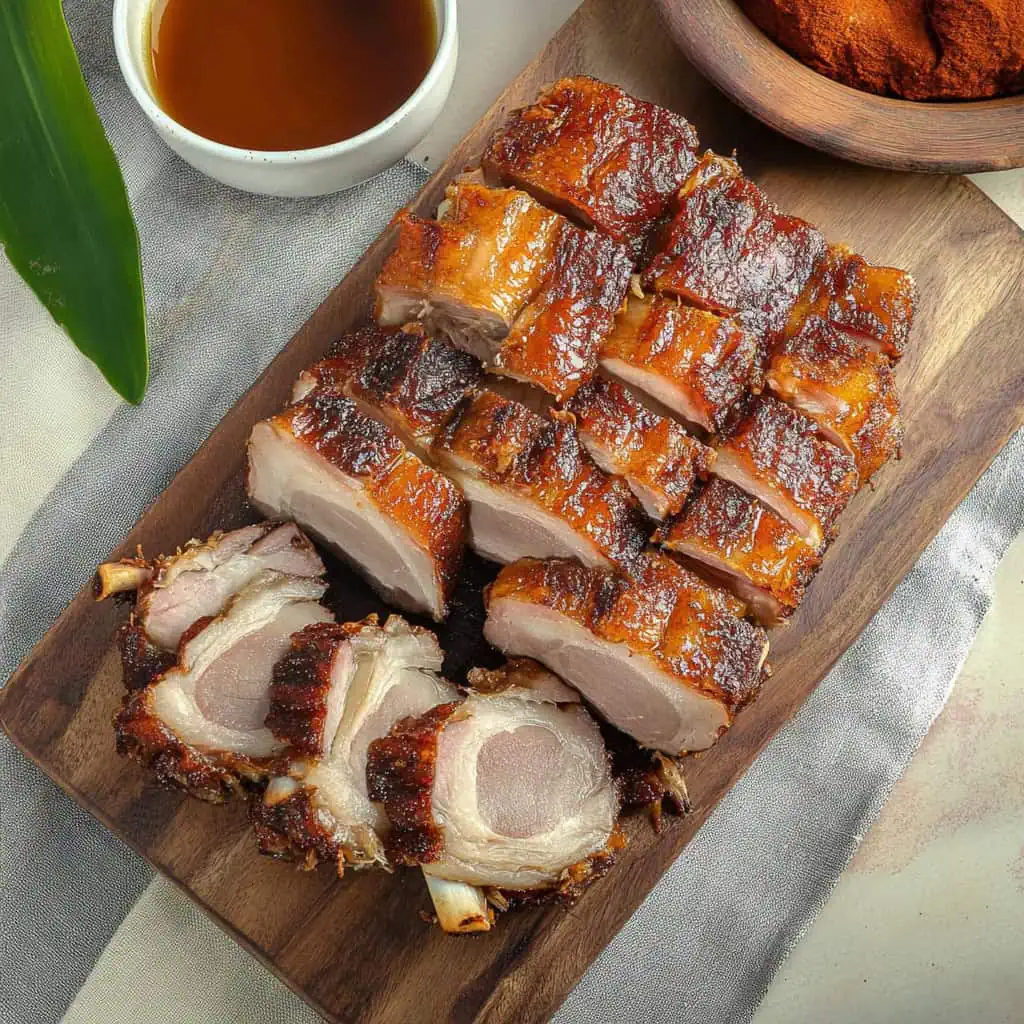
Why You'll Love This Recipe
- Restaurant-Quality Results: Achieve that coveted glass-like crispy skin (balat) and tender meat at home
- Budget-Friendly: Get the taste of whole lechon at a fraction of the cost
- Perfect for Small Gatherings: Ideal for family celebrations without needing a whole pig
- Foolproof Method: Step-by-step temperature guide ensures perfect results every time
- Make-Ahead Friendly: Most prep work can be done the day before
- Apartment-Friendly: No outdoor roasting pit needed
Ingredients
This simple ingredient list is the secret to authentic lechon flavor. Pork belly with skin provides the perfect fat-to-meat ratio and crispy skin potential. Vinegar helps tenderize the meat while beginning the drying process for the skin.
Salt enhances flavor and draws moisture out (crucial for crackling skin), while garlic powder and black pepper add classic Filipino savory notes without overwhelming the natural pork flavor.
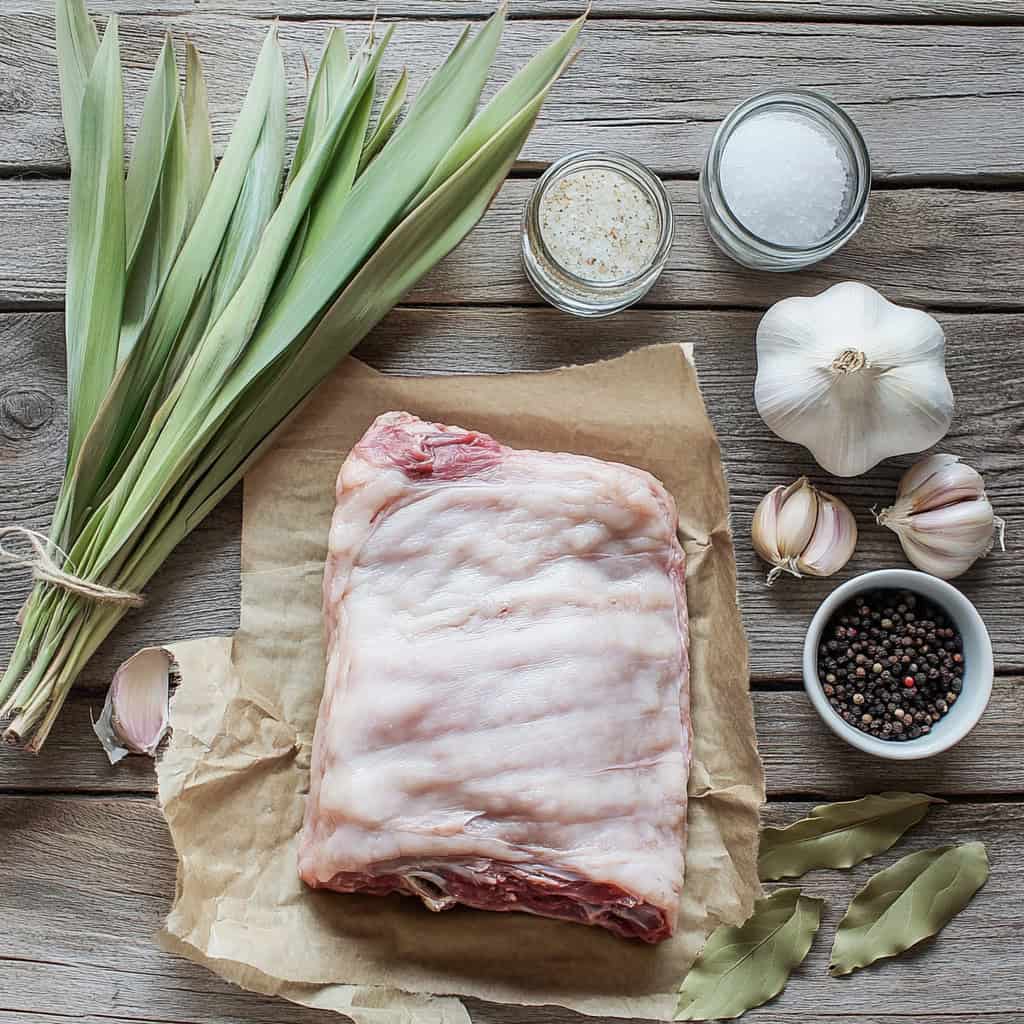
- 4 pounds pork belly with ribs (liempo)
- ½ cup vinegar
- 1 tablespoon salt
- 1 teaspoon garlic powder
- 1 teaspoon ground black pepper
Equipment
- Roasting pan with rack: Elevates the pork to allow hot air circulation and fat drainage for crispy results
- Meat thermometer: Ensures perfect doneness without guesswork (145°F/63°C is your target)
- Sharp knife: Essential for properly scoring the skin without cutting into the meat
- Paper towels: For thoroughly drying the skin, a crucial step for achieving crispiness
- Aluminum foil: Used if needed to protect parts from over-browning
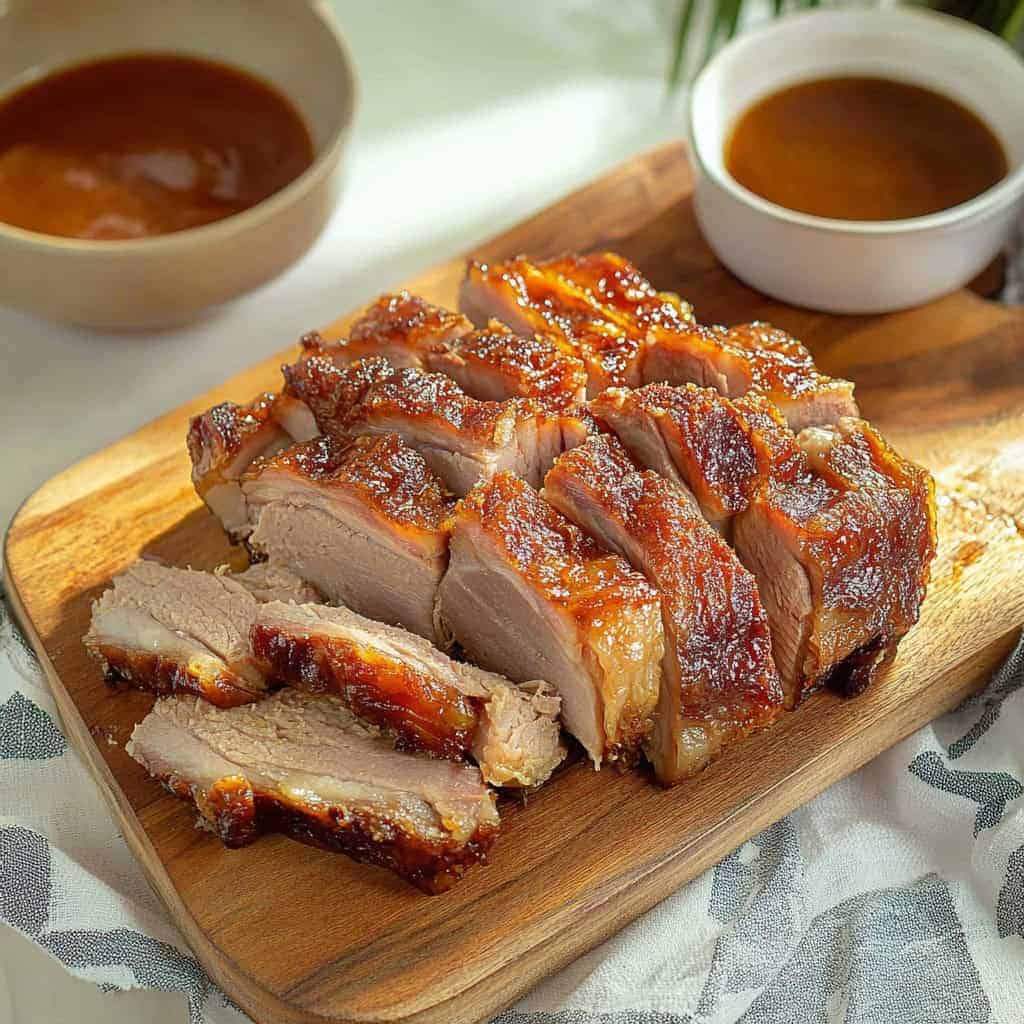
How to Make
- Prepare the pork belly: Remove pork belly from refrigerator and ensure it has skin and ribs attached. Clean thoroughly under cold running water. Pat the entire pork belly completely dry with paper towels. This step is crucial for achieving crispy skin.
- Score the skin: Using your sharpest knife, carefully score the skin in a diamond pattern, making sure to only cut through the skin and not into the meat. Make your cuts about 1 inch apart. If you cut too deeply into the fat or meat, the skin won't crisp up properly.
- Season the meat: Pour the vinegar into a small bowl. Using your hands, massage the vinegar all over both the meat and skin. In another bowl, combine the salt, garlic powder, and ground black pepper. Apply this seasoning mixture only to the meat portion, avoiding the skin completely. The skin should remain free of any seasonings to achieve maximum crispiness.
- Dry in refrigerator: Place the seasoned pork belly on a roasting rack with the skin facing up. Place the rack in your refrigerator, leaving the pork uncovered. Let it rest overnight or for at least 8 hours. This resting period allows the skin to dry out thoroughly, which is essential for achieving that glass-like crispiness.
- Bring to room temperature: Remove the pork from the refrigerator 1 hour before cooking. This allows the meat to come to room temperature, ensuring even cooking. Meanwhile, preheat your oven to 180°F (82°C).
- Slow roasting phase: Place the pork, still skin-side up, on the roasting rack in your preheated oven. Cook at 180°F for 3 hours. This low and slow cooking helps render the fat and tenderize the meat. Do not open the oven door during this time.
- Medium heat phase: After 3 hours, increase the oven temperature to 320°F (160°C). Continue cooking for another 1.5 hours. The meat will continue to tenderize while the skin begins to dry further.
- High heat finishing: For the final stage, raise the temperature to 430°F (220°C). Cook for 30-40 minutes, or until the skin has turned golden brown and is blistered all over. The skin should make a hollow sound when tapped with a knife.
- Check doneness: Ensure the internal temperature of the meat reaches 145°F (63°C) using a meat thermometer. Insert the thermometer into the thickest part of the meat, avoiding touching the bone or fat.
- Rest before serving: Once done, remove from the oven and let rest for 15-20 minutes before cutting. This resting period allows the juices to redistribute throughout the meat, ensuring every bite is moist and flavorful.
- Slice and serve: Slice the lechon using a sharp knife, making sure to cut through the crispy skin first to prevent it from separating from the meat. Serve immediately while the skin is still crispy.

Tips from Lola's Kitchen
- Pat the skin twice: Dry the skin thoroughly both before scoring and after applying vinegar
- Refrigerator position matters: Place the pork on the bottom shelf where it's coldest and driest
- Scoring technique: Hold the knife at a 45-degree angle for perfect skin cuts
- Vinegar application: Use white vinegar for traditional flavor, but apple cider vinegar works too
- Temperature accuracy: Use an oven thermometer to verify your oven temperature is accurate
- Patience pays off: Never rush the cooking process—each temperature stage is critical
- Listen to your lechon: Properly crisped skin makes a hollow sound when tapped with a knife
Substitutions
- Vinegar alternatives: Substitute calamansi juice or lemon juice for a different flavor profile
- Fresh aromatics: Replace garlic powder with 2 tablespoons of freshly minced garlic for more intense flavor
- Salt options: Sea salt or kosher salt can replace regular table salt for a cleaner flavor
- Additional herbs: For a more aromatic version, add 1 teaspoon of dried bay leaves (pulverized) to the spice mix
- Pork cut variations: While skin-on pork belly is traditional, you can use pork shoulder with skin for a leaner option
Troubleshooting
- Skin not crisping:
- Ensure skin was completely dry before and during refrigeration
- Verify no seasonings were applied to the skin
- Increase final temperature to 450°F for the last 10 minutes
- Make sure scores aren't too deep into the fat layer
- Meat too dry:
- Check oven temperature accuracy with a separate thermometer
- Reduce the final high-heat phase by 5-10 minutes
- Always use a meat thermometer to prevent overcooking
- Let the meat rest properly before slicing
- Uneven browning:
- Rotate the roasting pan halfway through each cooking phase
- Use aluminum foil to cover areas that brown too quickly
- Verify your oven doesn't have hot spots by moving the rack position
- Skin too tough:
- Scoring pattern may be too narrow—aim for 1-inch diamonds
- Final temperature may be too low—ensure it reaches 430°F
- Resting time in refrigerator may be insufficient
Storage & Reheating
- Refrigeration: Store leftovers in an airtight container in the refrigerator for up to 3 days
- Reheating method: Place in a preheated 350°F (175°C) oven for 15-20 minutes
- Re-crisping: After reheating, finish under the broiler for 2-3 minutes to restore crispiness
- Avoid microwave: Microwaving will make the skin soggy and ruin the texture
- Serving cold: Lechon can also be enjoyed cold the next day in sandwiches
- Freezing: While possible for up to 1 month, the skin texture will never be the same after freezing
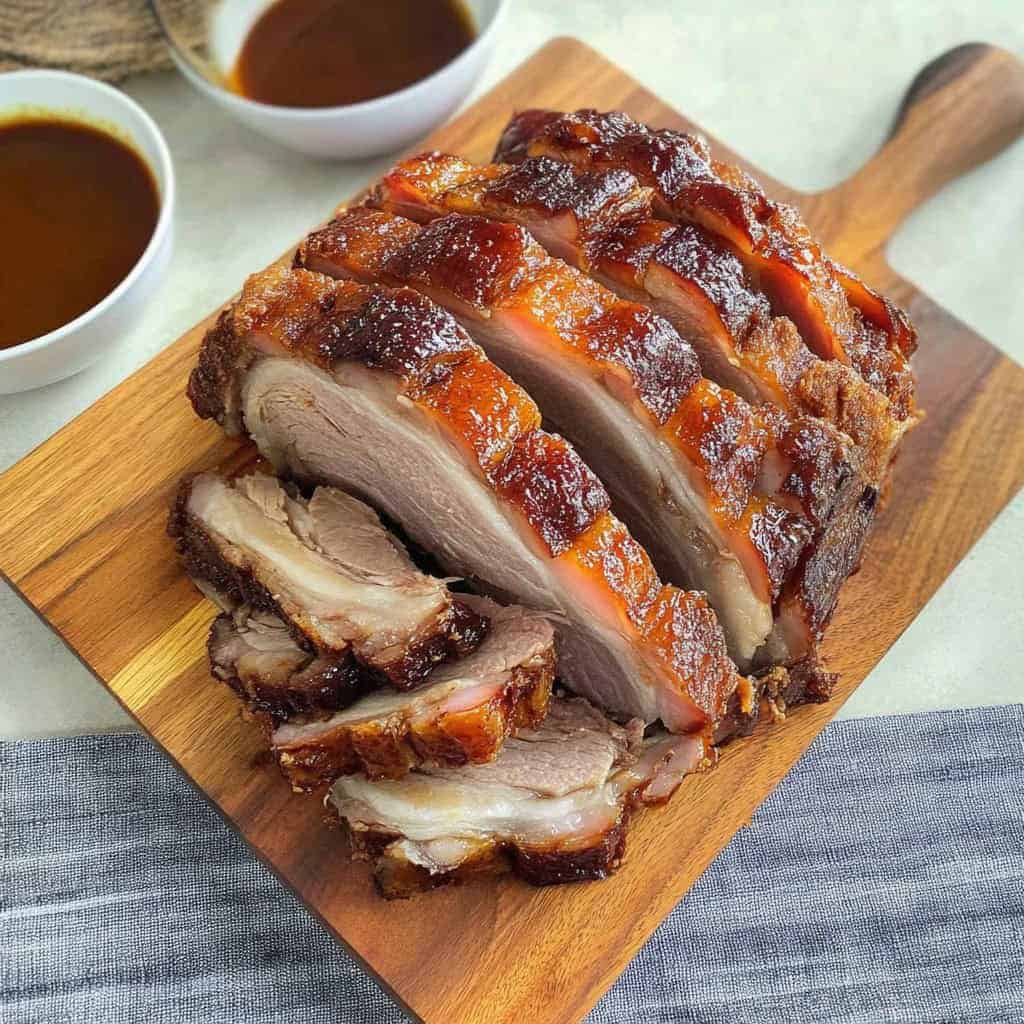
FAQ
Can I use skinless pork belly?
No, the skin is essential for authentic lechon sa hurno. The crispy skin is what makes this dish special.
How do I know when it's fully cooked?
The internal temperature should reach 145°F (63°C). A meat thermometer is your best friend here.
Can I marinate longer than overnight?
Yes, you can marinate for up to 24 hours for more flavor penetration, but don't exceed this as the meat can become too soft.
Why is my skin not getting crispy?
Ensure the surface is completely dry, no seasonings are on the skin, and follow the temperature stages carefully. Also, check that your oven reaches the proper temperatures.
Can I add stuffing to the pork belly?
Yes, you can butterfly the pork belly and add aromatics like lemongrass, garlic, and onions before rolling and tying it.
Is it necessary to use a rack when roasting?
Yes, the rack allows heat circulation and fat drainage, which is essential for crisping the skin evenly.
Can I cook multiple pieces at once?
Yes, but ensure there's at least 2 inches of space between pieces and you may need to extend cooking time slightly.
What's the best serving sauce?
Traditional options include Mang Tomas sauce, spiced vinegar, or liver sauce. Some regions prefer simple soy sauce with calamansi.
Related
Looking for other recipes like this? Try these:
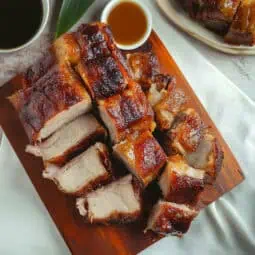
Lechon sa Hurno
Equipment
- Roasting pan with rack (pangihaw na may sapin)
- Meat thermometer (termometro para sa karne)
- Sharp knife [Matalas na kutsilyo]
- Paper towels
- Aluminum foil
Ingredients
- 4 pounds pork belly with ribs liempo
- ½ cup vinegar suka
- 1 tablespoon salt asin
- 1 teaspoon garlic powder
- 1 teaspoon ground black pepper dinurog na paminta
Instructions
- Get your pork belly from the refrigerator and check that it has skin and ribs attached (Kumuha ng liempo na may balat at tadyang). Clean the meat thoroughly under cold running water (Hugasang mabuti ang karne sa malamig na tubig). Using paper towels, pat the entire pork belly completely dry (Patuyuin ng mabuti gamit ang paper towel). This step is crucial for achieving crispy skin.
- Take your sharpest knife (matalim na kutsilyo) and carefully score the skin in a diamond pattern, making sure to only cut through the skin and not into the meat (Markahan ang balat ng diamond pattern, ingatan na hindi masugatan ang laman). Make your cuts about 1 inch apart. If you cut too deeply into the fat or meat, the skin won't crisp up properly.
- Pour the vinegar (suka) into a small bowl. Using your hands, massage the vinegar all over both the meat and skin (Ipahid ang suka sa buong karne at balat). In another bowl, combine the salt (asin), garlic powder (pulbos na bawang), and ground black pepper (dinurog na paminta). Apply this seasoning mixture only to the meat portion, avoiding the skin completely (Ipahid ang seasonings sa laman laman, hindi sa balat). The skin should remain free of any seasonings to achieve maximum crispiness.
- Place the seasoned pork belly on a roasting rack with the skin facing up (Ilagay ang inihaw na may nakatihaya ang balat). Place the rack in your refrigerator, leaving the pork uncovered (Ilagay sa ref ng walang takip). Let it rest overnight or for at least 8 hours. This resting period allows the skin to dry out thoroughly, which is essential for achieving that glass-like crispiness.
- Remove the pork from the refrigerator 1 hour before cooking (Ilabas sa ref 1 oras bago lutuin). This allows the meat to come to room temperature, ensuring even cooking. Meanwhile, preheat your oven to 180°F (82°C).
- Place the pork, still skin-side up, on the roasting rack in your preheated oven. Cook at 180°F for 3 hours. This low and slow cooking helps render the fat and tenderize the meat (Ito ay para matunaw ang taba at lumambot ang karne). Do not open the oven door during this time.
- After 3 hours, increase the oven temperature to 320°F (160°C). Continue cooking for another 1.5 hours. The meat will continue to tenderize while the skin begins to dry further (Patuloy na lulutuin ang karne habang natutuyo ang balat).
- For the final stage, raise the temperature to 430°F (220°C). Cook for 30-40 minutes, or until the skin has turned golden brown and is blistered all over. The skin should make a hollow sound when tapped with a knife.
- Check that the internal temperature of the meat reaches 145°F (63°C) using a meat thermometer. Insert the thermometer into the thickest part of the meat, avoiding touching the bone or fat.
- Once done, remove from the oven and let rest for 15-20 minutes before cutting (Palamigin ng 15-20 minuto bago hiwain). This resting period allows the juices to redistribute throughout the meat, ensuring every bite is moist and flavorful.
- Slice the lechon using a sharp knife, making sure to cut through the crispy skin first to prevent it from separating from the meat (Hiwain gamit ang matalas na kutsilyo, unahin ang pagputol sa crispy na balat). Serve immediately while the skin is still crispy.
- If you have leftovers, store them in an airtight container in the refrigerator for up to 3 days (Itago sa ref ng hanggang 3 araw). To reheat, place in a preheated 350°F (175°C) oven for 15-20 minutes, then finish under the broiler for 2-3 minutes to re-crisp the skin (Para muling initin, ilagay sa preheated na hurno ng 15-20 minuto, pagkatapos ay broil ng 2-3 minuto para muling kumaripas ang balat). Avoid using the microwave as this will make the skin soggy.
- To serve traditionally, pair with Mang Tomas sauce (sarsa), steamed rice (kanin), achara (pickled papaya), and spiced vinegar. You can also serve with fresh tomatoes and onions (kamatis at sibuyas) on the side.
Tips from Lola's Kitchen
- Pat the skin completely dry before and after refrigeration
- Score the skin evenly but don't cut into the fat layer
- Keep the oven door closed during cooking
- Let rest for 15-20 minutes before cutting
- Use a very sharp knife when scoring the skin
Nutrition
The Story Behind Lechon sa Hurno
Lechon sa hurno, which literally translates to "roasted in the oven" (hurno comes from the Spanish word "horno" meaning oven), represents the ingenious adaptation of the Philippines' most celebrated dish - the traditional lechon - for the modern home kitchen. While the conventional lechon requires a whole pig roasted on a bamboo spit over open coals, this innovative method brings the same beloved flavors and textures to Filipino homes worldwide.
The origins of lechon sa hurno can be traced to the resourceful Filipino home cooks of the 1960s and 1970s, when household ovens became more common in urban Filipino kitchens. These creative cooks, many of them working abroad or living in apartments where traditional lechon-making was impossible, developed this method to recreate the cherished taste of festivities and celebrations in a more practical way.
What makes this version particularly special is how it captures the two most prized elements of traditional lechon: impossibly crispy skin (balat) and tender, succulent meat. The signature slow-roasting technique, followed by carefully timed temperature increases, mimics the gradual heating and final crisping that happens during traditional pit roasting. This scientific approach to temperature control results in meat that stays incredibly moist while developing that coveted crackling skin that Filipinos call "kurikuri" - so crispy it makes a distinctive sound when you bite into it.
In many Filipino-American households, lechon sa hurno has become the go-to method for Sunday family gatherings and special occasions. It offers the perfect solution for those craving authentic lechon flavor without the need to order a whole roasted pig or wait for the next big celebration. The dish has also gained popularity among food bloggers and Filipino food enthusiasts worldwide, who appreciate how it makes this iconic dish accessible while maintaining its cultural significance.
Modern Filipino restaurants have embraced this preparation method too, often featuring it on their menus as "Oven-Roasted Lechon Belly" or "Crispy Boneless Lechon." Its popularity has soared with the rise of Filipino cuisine in the global food scene, as it perfectly represents how traditional dishes can be adapted without losing their soul. The convenience of preparation, combined with the reliability of results, has made it a favorite among both home cooks and professional chefs.
The beauty of lechon sa hurno lies not just in its delicious outcome, but in how it embodies Filipino culinary ingenuity. It shows how traditional recipes can evolve while maintaining their cultural integrity, making beloved flavors accessible to new generations and distant communities. Whether served at a casual family dinner or a special celebration, this dish continues to bring people together, just as traditional lechon has done for centuries.
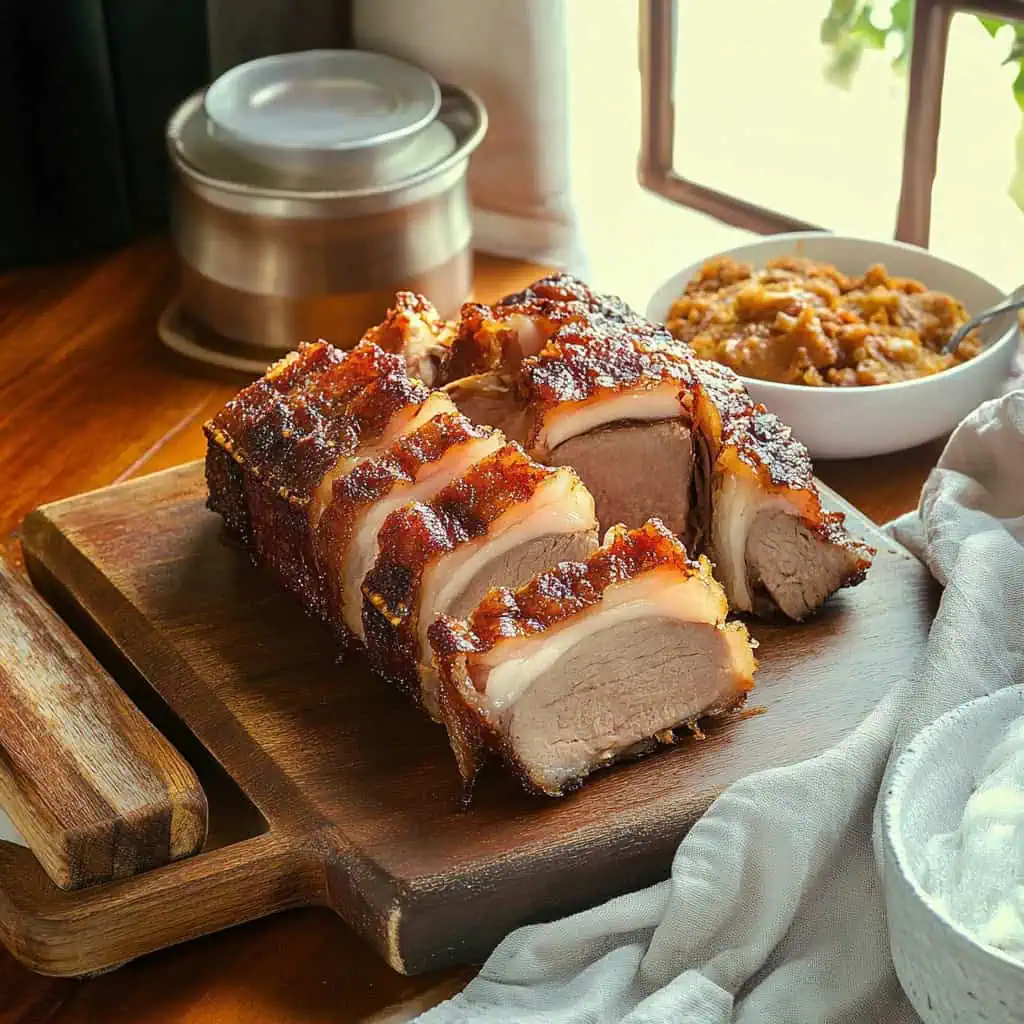









Comments
No Comments